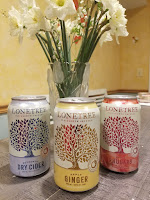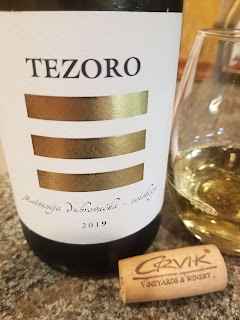The
American Cider Association's CiderCon 2023 took place in Chicago from February 1st through the 3rd and the event offered "a full range of educational sessions covering topics that included cider production, marketing, sales, branding, sensory evaluation, compliance, business strategy, and orcharding". We attended several of these sessions as well as the trade show, a tasting organized by the New York Cider Association, unofficial cider shares, as well as visiting a couple of local craft beverage establishments. Here are our five takeaways from the conference.
Consistent and Systemic Approach to Tasting CiderCideries and reviewers should create a systemic approach to both cider tasting and descriptors as advocated by Richie Brady in
A Proposal for a Systematic Approach to Tasting Cider. In other words, the industry should use a consistent method of describing the aromas, flavors, and structure of cider. This consistency involves focusing on the liquid in the glass, preferably in a blind fashion, without any preconceived expectations. Evaluate the
Aroma (light, medium, pronounced),
Flavor (in terms of major categories -- green, stone, citrus, tropic, red, and black fruit and then secondary flavors due to fermentation methods and oak treatments), and
Structure (intensity, sweetness, acidity, tannin, length, and complexity). Finally, use descriptors that consumers understand. Barely anyone knows what cassis tastes like so use a more common alternative. An example that Brandy provided is "Lightly sparkling, sweet and vibrant cider with pronounced flavors of stone and tropical fruit, fragrant flowers, sweet vanilla, and caramel. Long and complex finish".
Fire Blight
Apple and pear orchards are prone to numerous pests and diseases not unlike grapevines -- such as a shared threat from powdery mildew and deer. At the conference, I also heard orchardists discuss groundhogs, rabbits, squirrels, and various insects but it was during The 4 Components of Flavor: Orcharding for High-Flavor Fruit seminar presented by Stina Booth that I first heard of Fire Blight. This is a bacterial illness that affects fruit trees and thrives in hot, humid climates, usually appearing in the spring and declining as dryer summer temperatures occur. The bacteria infects trees undetectably in the fall or winter, hiding in branches and unopened buds. Then in the spring, it begins to emerge through openings in the branches and foliage and becomes apparent. Unfortunately, fire blight is very difficult to treat effectively, and overusing certain bacterial sprays can cause the tree to develop resistance to treatment. The best way to fight fire blight is prompt pruning and sanitizing tools. -- MinneopaOrchards.com

The conference coincided with
Chicago Cider Week and two urban cideries hosted several events and were accessible during the conference. The
Right Bee Cider Semi-dry Cider was available at a couple of spots at the host Chicago Hilton hotel and was a clean cider sweetened with honey from their own beehives. Their Dry Cider was also poured during an unofficial tasting and as I recall packed plenty of flavors. I was able to visit
Eris Brewery and Cider House where the brewery is located in a historic old masonic temple that was renovated in 2018. I started with the
Eris Cherish, a cherry cider produced in collaboration with Sleeping Village and the CIVL Foundation where the proceeds go towards providing music venue workers access to mental health awareness. I also turned to another collaboration, this time the Eris Apfelort which is a dry cider aged in used
Jeppson's Malört barrels from
CH Distillery. I had read about this wormwood-based digestif and how CH Distillery had purchased this "astringent and notoriously bitter 70-proof liqueur". The cider is neither and provides apples up front and subtle wormwood and a strong grapefruit finish.
Cider is North AmericanJust by casually talking to attendees it's easy to see that cider is produced throughout North America. We met producers and orchardists from north Georgia to Manitoba, across Canada, and from Nova Scotia to San Diego. I stood in line with a startup producer from Orlando and a representative from Bold Rock. I sat at tables with producers from Wisconsin, Oregon, and Tennessee and shared Michigan cider with the same from Pennsylvania, Virginia, and Ohio. The New York Cider Association hosted a tasting showcasing Empire State producers from the "Niagara Frontier to the Finger Lakes to the Catskills to the Hudson Valley to Long Island and to New York City". During unofficial cider shares, I sampled excellent cider from Washington State and Washington DC as well as from to. And my favorite cider of the week came from
Greenbench Mead & Cider in St. Petersburg, Florida with their
Giants in the Sky (Fresh-pressed Kingston Black, St Edmund's Russet, Pioneer, and Wickson Crab apples, wild-fermented in oak with native yeast.).
Cider is for EveryoneThis is the official theme of the American Cider Association but is also a true statement based on industry analysis presented in the
Alcohol Beverages and Cider: 2023 and Beyond and
More Than a Beverage: Cider Category Performance sessions. Presenters from both sessions showed industry and consumer data beneficial and discouraging for the cider industry. First, the total per capita consumption of ethanol has remained relatively constant for the past 20 years with beer being the largest, albeit, slowly declining sector. The volume of cider sold peaked in 2016 and slowly declined since - losing market share and shelf space to Hard Seltzers and to a lesser extent RTDs. The good news is that the average alcohol consumer is becoming "
Omnibibulous" a term created by Bart Watson, the Head Economist of the Brewers Association to describe how consumers are more "able and likely to drink almost anything (alcoholic)". And this group will continue to grow as younger consumers continue to experiment, and on the other hand, the baby boomers move into more leisurely lifestyles. Other facts based on consumer studies point to avenues where cideries can focus to attract customers. These studies show that 54% of all consumers have made a purchase in-store of a brand they first tried at a restaurant and 1/3 of cider consumers prefer a sweet version. Some ideas to consider.


















































